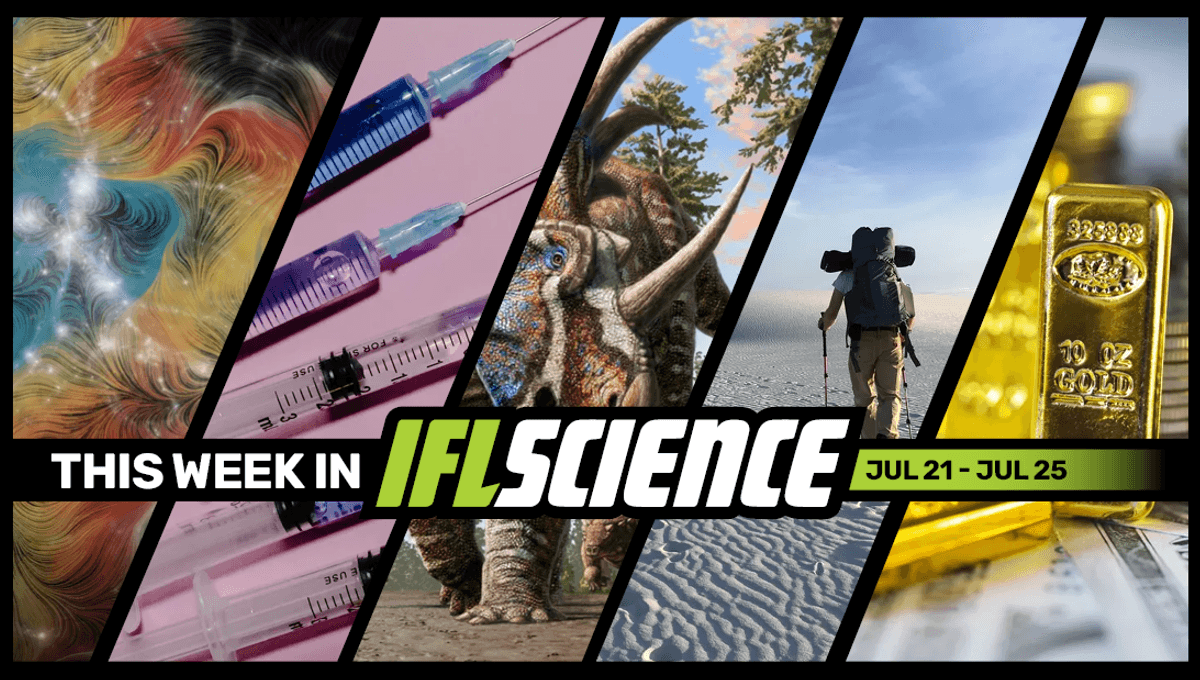This week, a Cretaceous-era trackway in Canada provides the first evidence of a dinosaur herd combining two species, scientists walked back on the claims that 10,000 is the optimal number of steps per day, and the so-called “entropy catastrophe” has been bypassed after researchers superheated gold to 14 times its melting point. Finally, we explore whether natural antidepressants are a legit alternative or just a load of nonsense.
Create an IFLScience account to get all the biggest science news delivered straight to your inbox every Wednesday and Saturday.
Missing 40 Percent Of Matter In The Universe Finally Discovered: “The Simulations Were Right All Along”
The regular matter that makes us, planets, stars, and galaxies is about 5 percent of the matter-energy content of the universe. The rest is made of dark matter and dark energy, though we are not sure what they are. There is also uncertainty around regular matter, since for a long time over one-third of it was not accounted for. Models had suggested that it would exist in the space between galaxies, and different groups using wildly different methods have now confirmed that it really is there. Read the full story here
Could We Be On Track Towards A Universal Cancer Vaccine? New Findings Say: Maybe
An experimental mRNA vaccine that supercharges existing cancer treatments could be laying the groundwork for a “universal” cancer vaccine, according to the team behind the breakthrough. Scientists at the University of Florida tested the innovation in mice and found it provoked a strong antitumor response when paired with immunotherapy. Read the full story here
First Evidence Of A Dinosaur Herd Combining Two Species Revealed In Cretaceous Tracks
A Late Cretaceous trackway in Canada contains the footprints of at least nine dinosaurs from four species. Two of the trackmakers were large tyrannosaurs, which may have sparked the motions of the other dinosaurs. However, while that part of the puzzle remains unsolved, the presence of both ceratopsians and an ankylosaurid moving together appears far more certain, suggesting multi-species herding similar to zebras and wildebeests during their great migration. Read the full story here
Here’s The Actual Number Of Steps You Should Walk Per Day (It’s Not 10,000)
We’re often told we need to walk “X number” of steps every day in order to stay healthy, although most of these claims are made by people who talk the talk but can’t walk the walk. With little or no scientific evidence to back up these daily benchmarks, it has until now remained unclear exactly how many times we should be putting one foot in front of the other. Read the full story here
Solid Gold Superheated To 14 Times Its Melting Point, Bypassing The “Entropy Catastrophe”
Researchers have been able to heat up a sample of solid gold to over 14 times its melting temperature for a fraction of a second, bypassing a theoretical limit known as the entropy catastrophe. The approach, known as superheating, might lead to a better understanding of how substances change phase at a fundamental level and even to improved production of materials. Read the full story here
TWIS is published weekly on our Linkedin page, join us there for even more content.
Feature of the week:
Natural Antidepressants: Legit Alternative Or A Load Of Nonsense?
What do zinc, bitter orange, lavender, saffron, and vitamin D all have in common? No, they’re not the ingredients to a bizarre-sounding salad, but they are all products that have been touted as natural antidepressants. The real question is – do any of them actually work? Read the full story here
More content:
Have you seen our e-magazine, CURIOUS? Issue 36 (July 2025) is available now. This month we asked, “How To Fake A Fossil” – check it out for exclusive interviews, book excerpts, long reads, and more.
PLUS, the We Have Questions podcast – an audio version of our coveted CURIOUS e-magazine column – continues. In episode 11, we ask, “Why Are Yawns Contagious?”
The Big Questions podcast has returned, and we’re continuing season 5 with episode 3’s big question: How Do Black Holes Shape The Universe?
